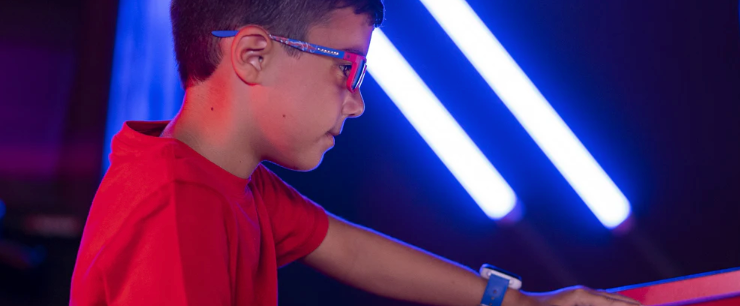Vision plays a crucial role in a child’s development, from learning in the classroom to exploring the world around them. Yet, eye health is often an overlooked aspect of pediatric care. Regular eye exams are essential to ensure children’s vision is developing correctly and to detect any potential problems early on. In this article, we’ll explore why eye exams are so important for children, what parents should expect during the process, and how to safeguard your child's vision for the future.
Understanding the Role of Vision in Childhood Development
Children rely heavily on their vision for learning and development. According to the American Optometric Association (AOA), up to 80% of learning occurs through visual tasks, such as reading, writing, and interacting with peers. From recognizing shapes and colors to improving hand-eye coordination, vision is a key driver of cognitive and motor development in children.
Unfortunately, many vision problems go unnoticed because children may not realize their vision is impaired—they assume what they see is normal. If left untreated, even minor visual impairments can lead to significant developmental delays and learning difficulties. That’s why early eye exams are essential in detecting vision issues before they impact a child’s ability to thrive.
Why Early Eye Exams Matter
The American Academy of Pediatrics (AAP) and the AOA recommend that children have their first eye exam as early as six months of age. Early screening helps identify congenital issues such as amblyopia (lazy eye) or strabismus (crossed eyes), which can be corrected with early intervention. If these conditions are not addressed in early childhood, they can result in permanent vision loss.
Here are several reasons why early and regular eye exams are critical for your child’s health:
1. Detecting Vision Problems Early
Many childhood vision problems are treatable if caught early. Conditions like nearsightedness (myopia), farsightedness (hyperopia), and astigmatism are common and can be managed with corrective lenses. Early detection through routine eye exams ensures your child receives the necessary treatment before these issues interfere with learning or development.
2. Preventing Long-Term Eye Health Issues
If a vision problem goes undiagnosed and untreated during childhood, it can lead to long-term eye health complications. For example, a child with undiagnosed amblyopia may experience reduced vision in one eye for life if the condition is not treated during their formative years. Regular eye exams allow for the early detection and treatment of such conditions, which can help prevent irreversible damage.
3. Supporting Academic Success
Children with vision problems may struggle in school, as their ability to read, write, and comprehend information can be compromised. Studies have shown that children with undiagnosed vision problems are more likely to fall behind academically. By ensuring your child has regular eye exams, you’re supporting their academic success and helping them reach their full potential in the classroom.
4. Enhancing Coordination and Motor Skills
Vision also plays a vital role in the development of motor skills. Eye exams can identify problems that might affect a child’s ability to perform tasks like catching a ball, riding a bike, or drawing. Ensuring your child has good vision helps improve their hand-eye coordination and overall motor development.
What to Expect During a Child’s Eye Exam
A child’s eye exam is tailored to their age, developmental stage, and specific needs. It typically involves a combination of tests to assess visual acuity, eye alignment, and overall eye health. Here’s what parents can expect during a routine eye exam for their child:
1. Visual Acuity Test
The most common eye test is the visual acuity test, which measures how clearly a child can see objects at different distances. For younger children who may not know letters, the optometrist might use pictures or symbols. For older children, a standard eye chart with letters is typically used.
2. Refraction Test
A refraction test determines whether a child is nearsighted, farsighted, or has astigmatism. During this test, the eye doctor uses a special device called a phoropter to measure how light enters the eye and identify the best corrective lenses to improve vision.
3. Eye Movement and Alignment Test
The optometrist will assess how well the eyes move and work together by asking the child to follow a moving object. This helps detect conditions like strabismus (crossed eyes) or nystagmus (uncontrolled eye movements). Ensuring proper eye alignment is critical for good depth perception and coordination.
4. Depth Perception Test
Stereopsis, or depth perception, is important for tasks that require good hand-eye coordination. The optometrist may use special 3D glasses to test whether your child’s eyes are working together to provide proper depth perception.
5. Eye Health Examination
To ensure your child’s eyes are healthy, the optometrist will check for any signs of eye diseases, such as cataracts or glaucoma, which, although rare in children, can still occur. The doctor may also dilate the pupils with eye drops to get a better look at the retina and optic nerve.
6. Color Vision Test
Some children are born with color blindness or have difficulty distinguishing between certain colors. A color vision test helps determine whether your child has any color vision deficiencies, which could impact their ability to learn in school.
How Often Should Children Have Eye Exams?
The AOA recommends the following schedule for eye exams:
If your child is diagnosed with a vision problem or requires corrective lenses, more frequent checkups may be needed to monitor progress and adjust prescriptions.





 UK site
UK site EU site
EU site US site
US site Canada site
Canada site